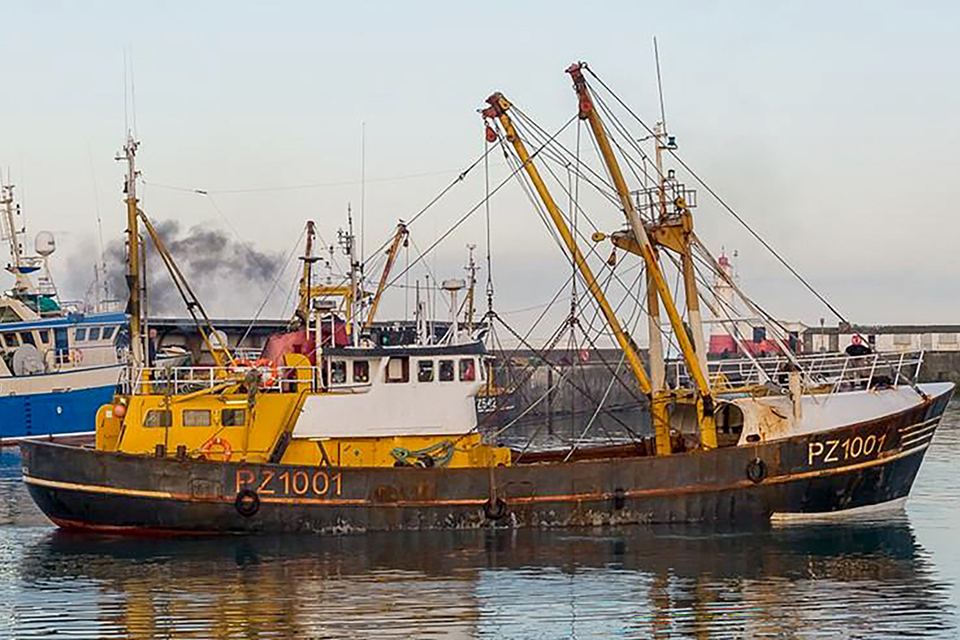Safety flyer to the fishing industry - Resurgam
Published 7 December 2023
1. Summary
Inadvertent discharge of a condensed aerosol fire-extinguishing system on board the fishing vessel Resurgam (PZ1001) on 15 November 2019

2. Narrative
At 1609 on 15 November 2019, an apprentice engineer died when a FirePro condensed aerosol fire-extinguishing system was inadvertently activated in the engine room of the fishing vessel Resurgam. The apprentice engineer together with a shore engineer and two installation technicians were working in the engine room when the system activated, filling the engine room with the fire-extinguishing aerosol.
All four people attempted to escape the engine room’s rapidly deteriorating atmosphere by climbing up an access ladder, which was the only exit. Three people escaped to the open deck but the apprentice engineer succumbed to the effect of condensed aerosol inhalation and collapsed at the foot of the ladder. The escape route for all four people passed in close proximity to a discharging fire-extinguishing generator. The apprentice engineer was later rescued by fire and rescue service personnel wearing breathing apparatus, but he could not be resuscitated and was pronounced dead at the scene.
At the time of the accident, Resurgam was undergoing a maintenance period and the skipper and crew were not on board. As the fishing vessel was non-operational and the work was being carried out by contractors, not under the control of the skipper or crew, the Health and Safety at Work etc. Act 1974 was applicable for all work activities on board.
3. Safety lessons
-
Any gaseous or particulate fire-extinguishing medium is hazardous to health when inhaled in significant quantities. The apprentice engineer died because he inhaled a concentrated mixture of hot particles and carbon monoxide and collapsed in a reduced oxygen atmosphere. Skippers of fishing vessels are to ensure that both they and their crew are aware of the hazards of exposure to fixed firefighting system media.
-
In the event that installation or maintenance of a fixed firefighting system is being undertaken, work in the area protected by the fixed firefighting system should be restricted to the people carrying out the work.
-
Fishing vessel crew do not usually consider an engine compartment an enclosed space. However, an engine space can become an enclosed space under the new regulations on enclosed spaces, MGN 659 (M+F) Amendment 1 The Merchant Shipping and Fishing Vessels (Entry into Enclosed Spaces) Regulations 2022, which came into force in May 2022 and applied to fishing vessels from May 2023.
-
The atmosphere in an engine space can rapidly change from a safe to a hazardous atmosphere for a number of reasons, including fumes emanating from hot work being carried out, leaking fluids and smoke emissions from overheating or smouldering machinery. In this case the inadvertent activation of a fire-extinguishing system adversely affected the breathable atmosphere and was harmful to anyone working in the engine room at the time. Make sure plans and procedures are in place so crew and contractors know how to react to such a situation.
-
The person in charge of the work in the engine space is responsible for ensuring that appropriate risk mitigation measures are taken before the work starts. This includes the completion of risk assessments and a detailed plan of the work, and identification of any conflicts with other tasks. As above, personnel working in the engine space need to know how to respond in an emergency.
4. Further information
Our accident investigation report is available at: https://www.gov.uk/maib-reports/accidental-discharge-of-condensed-aerosol-fire-extinguishing-system-on-beam-trawler-resurgam-with-loss-of-1-life.
Attention is also drawn to the lessons previously published in MAIB’s safety bulletin SB1/2020: https://www.gov.uk/maib-reports/safety-warning-after-inadvertent-activation-of-condensed-aerosol-fire-extinguishing-system-leads-to-a-fatality
Extract from The United Kingdom Merchant Shipping (Accident Reporting and Investigation) Regulations 2012 – Regulation 5:
The sole objective of the investigation of an accident under the Merchant Shipping (Accident Reporting and Investigation) Regulations 2012 shall be the prevention of future accidents through the ascertainment of its causes and circumstances. It shall not be the purpose of an such investigation to determine liability nor, except so far as is necessary to achieve its objective, to apportion blame.
Note:
This safety flyer is not written with litigation in mind and, pursuant to Regulation 14(14) of the Merchant Shipping (Accident Reporting and Investigation) Regulations 2012, shall be inadmissible in any judicial proceedings whose purpose, or one of whose purposes is to attribute or apportion liability or blame.
Marine Accident Investigation Branch
First Floor, Spring Place
105 Commercial Road
Southampton
SO15 1GH
Email iso@maib.gov.uk
Enquiries during office hours +44 (0)23 8039 5500
5. Photograph credit
Vessel photo above taken by Richard Kiessler, sourced via www.marinetraffic.com

